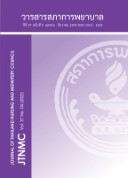Effects of Oral Care Programme on Oral Health Status and Ventilator-Associated Pneumonia Incidence
Keywords:
oral care programme, oral health status, ventilator-associated pneumoniaAbstract
Objective: To investigate ways in which an oral care programme could impact oral health status and incidence of ventilator-associated pneumonia (VAP) in intubated critically ill patients
Design: Two-group quasi-experimental research with a pre-test and a post-test
Methodology: The subjects were 50 critically ill patients aged 18 years and older, equally divided into a control group and an experimental group. Forty-nine registered nurses were recruited as programme implementers. The research instruments consisted of: 1) the oral care programme; 2) a ventilator-associated pneumonia (VAP) prevention kit; 3) a VAP diagnostic form and an assessment form for oral health status (OHAT); 4) the Silness-Löe Plaque Index (PI); 5) the supra-endotrachial tube cuff secretion score; and 6) a scale measuring nurses’ programme competence, programme adherence, and programme satisfaction. Descriptive statistics, mid p-value, 95% confidence intervals, two-way repeated measures ANOVA, and one-sample T-test were used to analyse the data.
Results: After participating in the programme, the experimental group’s mean scores on OHAT, PI, and secretion were lower than those of the control group (OHATexp = 3.9, OHATcon = 5.84; p < 0.001; = 0.46; PIexp = 0.99, PIcon = 1.96; p < 0.001; = 0.54; secretion scoreexp = 1.88 secretion scorecon = 2.63; p < 0.001; = 0.53, respectively). The experimental group’s mean OHAT, PI, and secretions scores on the 2nd, 4th, and 7th day after intubation had a tendency to decrease, whereas the control group’s scores tended to increase. Early-onset VAP was detected in neither group, whilst late-onset VAP was found only in the control group at the rate of 35.08 episodes/1,000 ventilator-days. The VAP incidence difference between the two groups was at -35.08 episodes/1,000 ventilator-days (p = 0.017; 95% CI [-63.16,-7.01]). The participating registered nurses displayed 98.64% (p < 0.001) programme competence, 99.14% (p < 0.001) programme adherence, and 93.8% (p = 0.002) programme satisfaction.
Recommendations: The oral care programme helped improve patients’ oral health status, decrease supra-cuff secretion, and reduce VAP incidence. The programme is feasible for clinical application
Downloads
References
Wang R, Zhen X, Yang B.Y, Guo X.Z, Zeng X, Deng CY. Subglottic secretion drainage for preventing ventilator associated pneumonia: a meta-analysis. Chin Nurs Res 2015;2(2):55-60.
Centers for Disease Control and Prevention. Pneumonia (ventilator- associated [VAP] and non-ventilatorassociated pneumonia [PNEU]) event. 2022 [Cited 2020 November 11]. Available from:https://www.cdc.gov/nhsn/PDFs/pscManual/6pscVAPcurrent.pdf
Wang Y, Eldridge N, Metersky ML, Verzier NR, Meehan TP, Pandolfi MM, et al. National trends in patient safety for four common conditions, 2005-2011. N Engl J Med 2014;370(4):341-51.
Thamcharoentrakul B, Saensom D. Effects of using nursing practice guideline for ventilator associated pneumonia prevention: medical department. Journal of Health and Nursing Education 2019;25(1):25-42. (in Thai)
Khon Kaen University. Faculty of Medicine. Srinakarin hospital. Nursing services department. Semi-critical medicine wards 4B2. Surveillance notebook 2019. (in Thai)
Wu D, Wu C, Zhang S, Zhong Y. Risk factors of ventilator-associated pneumonia in critically III patients. Front Pharmacol 2019;10:482. doi: 10.3389/ fphar.2019.00482.
Saensom D, Merchant AT, Wara-Aswapati N, Ruaisungnoen W, Pitiphat W. Oral health and ventilator-associated pneumonia among critically ill patients: a prospective study. Oral Dis 2016;22(7): 709-14.
Najafi MH, Taheri M, Mokhtari MR, Forouzanfar A, Farazi F, Mirzaee M, et al. Comparative study of 0.2% and 0.12% digluconate CHX mouth rinses on the level of dental staining and gingival indices. Dent Res J 2012;9(3):305-8.
Hoshijima H, Kuratani N, Takeuchi R, Shiga T, Masaki E, Doi K, et al. Effects of oral hygiene using CHX on preventing ventilator-associated pneumonia in critical-care settings: a meta-analysis of randomized controlled trials. JDS 2013;1(8):348–57.
Martin-Loeches I, Rodriguez AH, Torres A. New guidelines for hospital-acquired pneumonia/ventilator-associated pneumonia: USA vs. Europe. Curr Opin Crit Care 2018;24(5):347-52.
Longlalerng W, Ua-Kit N. The effect of a clinical nursing practice guideline for oral care in critical patients with endotracheal tubes. Thai Journal of Cardio-Thoracic Nursing 2016; 27(1):98-113. (in Thai)
Ayanian JZ, Markel H. Donabedian’s lasting framework for health care quality. N Engl J Med 2016; 375(3): 205-7.
Thanomseing N. Sample size determination. 2018 [cited 2019 March 15]; Available from:https://home.kku.ac.th/nikom/516201_sample_size_nk2561.pdf (in Thai)
Sripanom S, Saensom D. Effects of the WHAPO-CRE clinical nursing practice guideline among intubated patients. Journal of Nursing and Health Care 2020; 38(4):181-90. (in Thai)
Moslehzadeh K. Silness-Löe index. 2011 [cited 2020 March 11]. Available from: https://www. mah.se/CAPP/Methods-and Indices/Oral-Hygiene-Indices/Silness-Loe-Index.
Nicolosi LN, del Carmen Rubio M, Martinez CD, González NN, Cruz ME. Effect of oral hygiene and 0.12% chlorhexidine gluconate oral rinse in preventing ventilator-associated pneumonia after cardiovascular surgery. Respir Care 2014;59(4):504-9.
Chaichanawirote U, Vantum C. Evaluation of content validity for research instrument. Journal of Nursing and Health Sciences 2017;11(2):105-11. (in Thai)
Thamcharoentrakul B, Saensom D. Supra-cuff suction: innovation for ventilator-associated pneumonia prevention. The Journal of Baromarajonani college of nursing Nakhonratchasima 2018;24(1):130-42. (in Thai)
Saechua T, Kongwattananon M, Bauthong J, Kitbunyonglers S, Petpichetchian W. Effects of an oral care programme on oral hygiene and ventilator-associated pneumonia amongst critically ill patients:a randomised controlled trial. Thai Journal of Nursing Council 2018;33(4):46-63. (in Thai)
Labeau SO, Van VK, Brusselaers N, Vogelaers D, Blot SI. Prevention of ventilator-associated pneumonia with oral antiseptics: a systematic review and meta-analysis. Lancet Infect Dis 2011;11(11): 845-54.
Mao Z, Gao L, Wang G, Liu C, Zhao Y, Gu W, et al. Subglottic secretion suction for preventing ventilator-associated pneumonia: an updated meta-analysis and trial sequential analysis. Crit Care 2016;20(1):e353. doi: 10.1186/s13054-016-1527-7.
Kheiawsawang M, Sopaporm O, Siripitayakunkit A, Sutherasan Y. The effects of nursing practice guidelines to prevent ventilator associated pneumonia (VAP) in Medical Intensive Care Unit, Ramathibodi Hospital. Mahidol R2R e-Journal 2019;7(1): 98-109. (in Thai)
Downloads
Published
How to Cite
Issue
Section
License
Copyright (c) 2022 Thai Journal of Nursing Council

This work is licensed under a Creative Commons Attribution-NonCommercial-NoDerivatives 4.0 International License.








